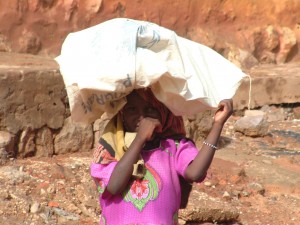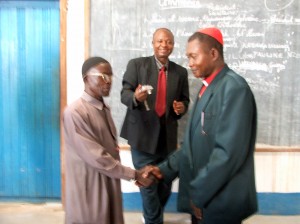The Context
 Africa is growing and changing every day. Those who have spent any length of time in Africa have seen the population growth- mainly in the capital cities. This growing and changing environment is contrasted by the lack of growth and change in the social, political and economic sectors. As the population is increasing in numbers all over Africa, some countries are facing serious problems in maintaining the growth and movement of their populations. Others lack even a viable infrastructure to contain their populations within their borders and create more life opportunities. As populations grow, so too grows a sense of dissatisfaction, humiliation and shame among many Africans- especially the young.
Africa is growing and changing every day. Those who have spent any length of time in Africa have seen the population growth- mainly in the capital cities. This growing and changing environment is contrasted by the lack of growth and change in the social, political and economic sectors. As the population is increasing in numbers all over Africa, some countries are facing serious problems in maintaining the growth and movement of their populations. Others lack even a viable infrastructure to contain their populations within their borders and create more life opportunities. As populations grow, so too grows a sense of dissatisfaction, humiliation and shame among many Africans- especially the young.
As in other places, the end of the Cold War (1989) has increased the number of challenges any government has to face. The nature and sources of conflict, for example, have dramatically changed and reveal a need for serious inquiry. The presence of new, often non-state actors (warlords), and the increasing numbers of cross-border wars are among many of the new phenomena Africa is facing (Rwanda, Burundi, DRC, Sudan, Tchad, DRC, Congo-Brazzaville, Uganda, Somali, Kenya). Armed conflict and the number of internally and externally displaced people have also created a new phenomenon in conflict study in the continent. Refugees populations are no longer composed solely of civilians only but now are often mingled with armed groups, the former army and even members of the overthrown government- as was seen in the aftermath of the ‘94 Rwandan Genocide.
Once in refugee camps or in exile, those groups (known as negative forces) can take advantage of the proximity of the refugee camps to their former countries, reorganizing themselves and launching attacks which create regional insecurity and destabilization as demonstrated in recent case of South Sudan- North of DR Congo (January2017). Like during the apartheid regime in South Africa, the regime conducted incursion in neighboring countries such as Lesotho, Botswana and Swaziland to track down black south Africans refugees. The same happened when in 1996 regimes in the Great Lakes Region of Africa including Rwanda-Burundi-Uganda and the Democratic Republic of Congo fought each other or accused one another of harboring refugees, the same thing happened in West and Southern Africa including Liberia-Sierra Leone, Liberia-Sierra Leone- Guinea (Conakry), Namibia- Botswana, Zambia-Angola, Namibia-Angola, Sudan-Uganda etc…
Most of these inter-state conflicts began with the presence of people displaced from their homelands, who attempt to return by use of force as a rebel movement. In other cases, conflict erupts as former refugees return, demanding to regain their land and belongings.
 FARDC Uvira
FARDC Uvira
The other phenomenon observed is that of national identity- as is the case in Congo-DRC (the Banyamulenge issue), and in Cote d’Ivoire (with A. Ouattara). This phenomenon, identified as Identity Conflict, has its origins in the non-recognition of cultural differences among many. This inability and unwillingness to transcend cultural differences is generated by the myth of origins and the lack of structural land reform policies.
While Africa is struggling with the logic of a first come, first served, or that of a winner-take- all, the dawn of the twenty-first century has introduced yet another challenge for Africa: the global village. The reality of the global village requires that cultures co-exist peacefully if they are to benefit from access to the world market. How can Africans live in a global village without making their cultural differences a political weapon to eliminate those who have been targeted as political opponents? How can Africans transform their usage of culture from being a source of conflict to a resource of peace?
There exist many ways to respond to these new challenges to Africa. One can be education through training programs, which can create opportunity for local communities to gather and learn from each other. Is this utopian, or an idealistic vision of a solution to Africa’s problems? How can this vision be practical, possible and effective? What should be done? The Context
Africa is growing and changing every day. Those who have spent any length of time in Africa have seen the population growth- mainly in the capital cities. This growing and changing environment is contrasted by the lack of growth and change in the social, political and economic sectors. As the population is increasing in numbers all over Africa, some countries are facing serious problems in maintaining the growth and movement of their populations. Others lack even a viable infrastructure to contain their populations within their borders and create more life opportunities. As populations grow, so too grows a sense of dissatisfaction, humiliation and shame among many Africans- especially the young.
As in other places, the end of the Cold War (1989) has increased the number of challenges any government has to face. The nature and sources of conflict, for example, have dramatically changed and reveal a need for serious inquiry. The presence of new, often non-state actors (warlords), and the increasing numbers of cross-border wars are among many of the new phenomena Africa is facing (Rwanda, Burundi, DRC, Sudan, Tchad, DRC, Congo-Brazzaville, Uganda, Somali, Kenya). Armed conflict and the number of internally and externally displaced people have also created a new phenomenon in conflict study in the continent. Refugees populations are no longer composed solely of civilians only but now are often mingled with armed groups, the former army and even members of the overthrown government- as was seen in the aftermath of the ‘94 Rwandan Genocide.
Once in refugee camps or in exile, those groups (known as negative forces) can take advantage of the proximity of the refugee camps to their former countries, reorganizing themselves and launching attacks which create regional insecurity and destabilization as demonstrated in recent case of South Sudan- North of DR Congo (January2017). Like during the apartheid regime in South Africa, the regime conducted incursion in neighboring countries such as Lesotho, Botswana and Swaziland to track down black south Africans refugees. The same happened when in 1996 regimes in the Great Lakes Region of Africa including Rwanda-Burundi-Uganda and the Democratic Republic of Congo fought each other or accused one another of harboring refugees, the same thing happened in West and Southern Africa including Liberia-Sierra Leone, Liberia-Sierra Leone- Guinea (Conakry), Namibia- Botswana, Zambia-Angola, Namibia-Angola, Sudan-Uganda etc…
Most of these inter-state conflicts began with the presence of people displaced from their homelands, who attempt to return by use of force as a rebel movement. In other cases, conflict erupts as former refugees return, demanding to regain their land and belongings.
 The other phenomenon observed is that of national identity- as is the case in Congo-DRC (the Banyamulenge issue), and in Cote d’Ivoire (with A. Ouattara). This phenomenon, identified as Identity Conflict, has its origins in the non-recognition of cultural differences among many. This inability and unwillingness to transcend cultural differences is generated by the myth of origins and the lack of structural land reform policies.
The other phenomenon observed is that of national identity- as is the case in Congo-DRC (the Banyamulenge issue), and in Cote d’Ivoire (with A. Ouattara). This phenomenon, identified as Identity Conflict, has its origins in the non-recognition of cultural differences among many. This inability and unwillingness to transcend cultural differences is generated by the myth of origins and the lack of structural land reform policies.
While Africa is struggling with the logic of a first come, first served, or that of a winner-take- all, the dawn of the twenty-first century has introduced yet another challenge for Africa: the global village. The reality of the global village requires that cultures co-exist peacefully if they are to benefit from access to the world market. How can Africans live in a global village without making their cultural differences a political weapon to eliminate those who have been targeted as political opponents? How can Africans transform their usage of culture from being a source of conflict to a resource of peace?
There exist many ways to respond to these new challenges to Africa. One can be education through training programs, which can create opportunity for local communities to gather and learn from each other. Is this utopian, or an idealistic vision of a solution to Africa’s problems? How can this vision be practical, possible and effective? What should be done? Who should do it? Where and in what manner? All these questions will be elicited in this training manual.
Who should do it? Where and in what manner? All these questions should be elicited by those involved in Peacebuilding.
